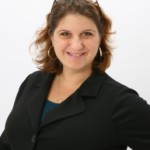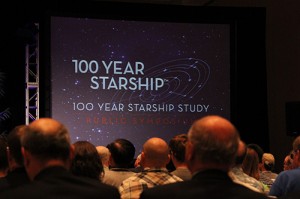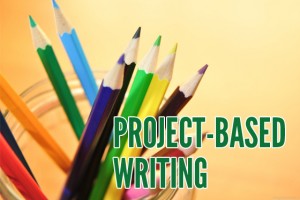 Next month Heather Wolpert-Gawron will be leading a lively new e-course from Powerful Learning Practice, aimed at engaging your new millennial students around a teaching stategy she calls Project-Based Writing.
Next month Heather Wolpert-Gawron will be leading a lively new e-course from Powerful Learning Practice, aimed at engaging your new millennial students around a teaching stategy she calls Project-Based Writing.
In the interview below, Heather explains just what she means by Project-Based Writing and why you’re likely to find it as exciting as she and her students do. (The course begins February 6. You can register here.)
Heather is an award-winning middle school teacher in San Gabriel, California and the author of the popular education blog Tweenteacher. She also blogs at the Huffington Post and for Edutopia (George Lucas Educational Foundation) where she helps lead a middle school discussion group. Her first full-length book ‘Tween Crayons and Curfews: Tips for Middle School Teachers was published by Eye on Education in 2011.
A member of the national Teacher Leaders Network and a Fellow of the National Writing Project, Heather describes herself as “devoted to helping teachers regain control of their profession through elevating their practice and educating themselves on policy.” She’s also very funny.
She met her husband Royce as a 2nd grader (after karate-chopping him on the playground to indicate her interest). Her son Ben began public school this fall, and her second son Samwise (yes, like the Hobbit), will soon celebrate his first birthday. (While Heather doesn’t often mention it, we also like to gossip that her dad, Jay Wolpert, wrote the screenplay for The Count of Monte Cristo and the screen story for the first Pirates of the Caribbean.)
John Norton (PLP’s coordinator of content and capacity building) skyped with Heather recently to catch up on the news (they’re bicoastal friends) and, of course, to find out more about the e-course and the big ideas behind Project-Based Writing.
_________
1. Give us the elevator speech on Project-Based Writing. Your skinny definition.
OK, this is about as skinny as it gets!
Most teaching of writing is “silo-ed” by genre or curriculum sequencing, based on the arbitrary district or state assessments that dictate the teaching. It is almost robotic to a teacher: [think 50’s sci-fi artificial voice] “It is now time to teach Narrative. It is now time to teach Persuasive. It is now time to teach Literary Analysis.” Where I teach, as each quarter ends, a wall is built that that seems to forbid our usage of the genres previously covered.
Project-Based Writing (PBW) is about more authentic, purposeful ways to teach, learn and use writing. Does the kind of writing we’re teaching exist out in the real world? In other words, does it have a real-world application? If it can be found outside of school, then we as teachers can mine it for application within school.
The learners in this eCourse will end up producing a PBW portfolio — based on units they and other participants create — of authentic writing projects with real world connections. They will walk out and go about with a meaningful digital curriculum binder to use “Monday or Someday.”
2. How did you dream this up? Did we hear you’re writing a book about it?
My motto this year is “If it doesn’t exist outside of school, then it isn’t worthy enough to be taught within school.” As a Language Arts teacher, I made it my goal to relate all of the writing activities in my classroom to the ways writing is really happening outside our walls.
I recently wrote 4 workbooks on this topic for a publisher of teacher guides. They cater to 3rd graders through middle school. It helped me organize my ideas in a more scaffolded and targeted way, creating a step-by-step that will guide students through a more authentic, real-world writing process.
Between creating these worksheets for all those grade levels and looking at the overview and pacing of my own classroom, I began to fine-tune this pedagogical strategy that has proven to be really engaging to the students I guide daily.
2. How about an example or two of PB Writing from your own classroom?
Sure thing. One of the units I share was one of the most exciting things that ever happened in any of my classrooms in my teaching career. This summer, I was thinking about how to make persuasive writing more authentic. I stumbled on a conference that DARPA and NASA were hosting that was meant to be a meeting of the world’s greatest scientists, science-fiction writers, futurists, and ethicists. The idea was to have them brainstorm together about what would be needed to sustain a 100-Year Starship colonization program.
 To attend the conference, you had to fill out an application that used persuasive writing to convince the committee that you could contribute something substantial to the conversation. Well, I had my students pretend to apply for the conference. They role-played their area of expertise and conducted research on different topics from the science of space travel, to the biological challenges of human space habitation, to the ethical and social-emotional implications of leaving Earth. The kids became science experts, but I became the guide in helping them structure their communication and practice the art of using language. Language Arts, right?
To attend the conference, you had to fill out an application that used persuasive writing to convince the committee that you could contribute something substantial to the conversation. Well, I had my students pretend to apply for the conference. They role-played their area of expertise and conducted research on different topics from the science of space travel, to the biological challenges of human space habitation, to the ethical and social-emotional implications of leaving Earth. The kids became science experts, but I became the guide in helping them structure their communication and practice the art of using language. Language Arts, right?
Anyway, I reached out to my friend at CalTech and asked if she could come in and listen to their panel presentations as an authentic audience. She said, “Sure!” and also said she’d ask some colleagues if they’d like to join her. Cut to two weeks later (my family’s in the movie business – we talk like that). I get an email from DARPA asking if my students can present, via Skype, as a session at the actual conference in Florida!
The students selected representatives for each of their topics and created a conference panel. We were all in virtual attendance, and it was remarkable. Our 40-minute session came on Day 1, just before the first Science Fiction Writers Panel (good placement!). The kids really understood the magnitude of what they had been invited to participate in. NASA! DARPA! They stood up to the rigor and were a part of a legacy for their own children and grandchildren by contributing to this amazing conversation.
3. How does PB Writing synch up with other shifts going on in teaching and learning: inquiry, passion, tech infusion, Web tools and connectivity? And let’s not forget the Common Core.
It involves all of these things. PBW is project/problem/passion based learning. It’s about questioning and discovery. It’s all about blended learning, face-to-face and online. It’s all about reciprocal teaching, where both the students and the teacher are stakeholders learning from each other.
In the case of the DARPA conference, I didn’t know a thing about the content or the science that the students were researching (Language Arts, right?). I became their guide as they worked to polish their writing and speaking skills (I also teach debate) and communicate that content — nothing more. I arguably learned more than they did! As a result, I modeled lifelong learning, and modeling is the best way to teach, I think.
In terms of Common Core, PRW is all about role-playing, teaching via scenarios, and authentic learning. The new Common Core standards expect use to use more of these strategies, so PBW falls quite nicely into place in this new standards movement.
4. Who should take this course?
I think a lot of educators in different roles can apply what they learn in this course to their daily work. It’s not just for E/LA teachers — all teachers should be using writing as both a learning tool and a means of expressing the language of their disciplines. Instructional coaches, for sure. Principals who want to “21st Centurize” their writing programs — tune in! And I don’t intend to limit the focus to the middle grades. We’re going to be talking PK-12, with participants all bringing your expertise to the table.
Problem-based writing is about a philosophical shift in how one teaches. I know from my own experience in other areas of improving teacher practice that it is easier to jump in when you have people moving ahead of you, sharing lessons learned and blazing a trail we can follow and expand. That’s how I see my position as facilitator. I want to share what’s worked for me and what hasn’t and provide some scaffolds that might make your own journey easier.
5. What will participants learn and how much fun will they have? What’s your e-course teaching style?
I believe that the best teachers are also students. Being a part of an online learning community is all about learning from each other. I plan to provide the structure and the downloads and the prompts to begin our studies, but I fully intend to participate as a learner with everybody else in the room.
I say in my book ‘Tween Crayons and Curfews that happiness in this job is trickle-down. If we’re having a good time as teachers, then our students will too. By that same notion, PD should be like that too. I’m a pretty transparent guide; I love what I do and I hope that enthusiasm is contagious.
6. What’s the next e-course you’d like to lead? The next idea that excites you?
Gosh, which idea do you mean? My issue is always in selecting just one of the many topics I’m excited to talk about. I always love those crazy middle schoolers and eventually, I’d love to help others see how great a developmental level they are to teach and talk together about all the diverse strategies that work with these grade levels.
On the other hand, my passion for transparent teaching is something I am embracing more and more of in my own daily practice. I would love to see others embedding a more transparent practice too. That can mean so much to teaching as a profession. Good publicity about our practice, I believe, is what will drive our profession to new levels of respect.
I’ve also presented at conferences about teaching students to use commentary as a learning strategy. The techniques I’ve developed are, I think, exciting and effective. I’d love to develop this into a class that helps other teachers coax original thoughts from students, inspired by their academic readings. Wouldn’t that be awesome?
 Heather’s PLP e-course Project-Based Writing begins February 6.
Heather’s PLP e-course Project-Based Writing begins February 6.
Sign up here!
Latest posts by Powerful Learning Practice (see all)
- Hurry, you do not want to miss out on this… - November 3, 2020
- Resist the Urge to Quit Prematurely - October 26, 2020
- Let’s Move Past Feeling Disconnected from Your Students. Words Matter - October 24, 2020


This sounds amazing, and I can feel Heather’s energy and enthusiasm just reading the interview!! I am taking two graduate courses that begin at the end of January, as well as leading a team in a 6-month professional development program that begins this month, so PLEASE tell me you’ll keep this on the list and offer it again when I have time!
If there is an interest we will indeed offer another section. Help us spread the news. Maybe you know someone who isn’t as busy as you who might want to take this or one of our other courses?
Thanks as always Patti for all you do.
Well…I’ll try this again. If you’d like to buy the DVD of this, just go to the WNET PBS station website, and you can, with a little effort, find the info there. Good Lord, you people see how many Folks want to buy this, how about NOT removing my post with the info?